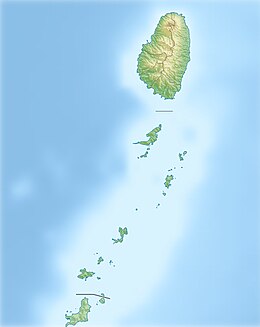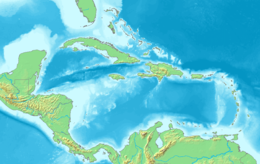Baliceaux
Native name: Balliceaux | |||||||||||||
|---|---|---|---|---|---|---|---|---|---|---|---|---|---|
 Baliceaux Island | |||||||||||||
| Geography | |||||||||||||
| Location | Caribbean | ||||||||||||
| Coordinates | 12°57′00″N 61°08′45″W / 12.95000°N 61.14583°W | ||||||||||||
| Archipelago | Grenadines | ||||||||||||
| Area | 320 acres (130 ha)[1] | ||||||||||||
| Highest point | 126 m. Gun Hill | ||||||||||||
| Administration | |||||||||||||
| Additional information | |||||||||||||
| Time zone | |||||||||||||
private island
| |||||||||||||
Baliceaux is a small, privately owned [1] Caribbean island and is one of the Grenadines chain of islands which lie between the larger islands of Saint Vincent and Grenada. Politically, it is part of the nation of Saint Vincent and the Grenadines.[2]
History
[edit]Discovered by Spanish navigators during the fifteenth century, this island of 1,35 km² enjoyed a long and interesting history. It got prominence during wars 1769 - 1795 within the Caribbean region. Island highest point Gun Hill, almost 126 meters above sea level, served as an observation station for soldiers between 1772–1797. In the 1790s, the British army banished about 5000 Black Caribs to Baliceaux following the defeat of the rebellion of Carib Chief Joseph Chatoyer in Saint Vincent. Due to starvation, disease, and sickness from exposure to the elements on the undeveloped island, more than half Garifuna people died on Baliceaux. Unsuccessful in their first attempt to eradicate the Garifuna population by way of exile to the barren island, The British exiled approximately 2,500 survivors to the island of Roatan, Honduras. [3] Their descendants live today as the Garifuna people in Honduras, Belize, Guatemala, Nicaragua and in the United States.
The graves and remains of those who died on Baliceaux have never been officially marked or excavated.[2] It is essentially, a graveyard. Due to this sensitive history and the obvious physical challenges, the development of the island is unpopular and unlikely.
To commemorate these events every year in March Pilgrimage to Balliceaux is held. It coincides with National Hero's Day in St. Vincent.[4] The cultural landmark status is proposed for Baliceaux island.[5]
See also
[edit]References
[edit]




